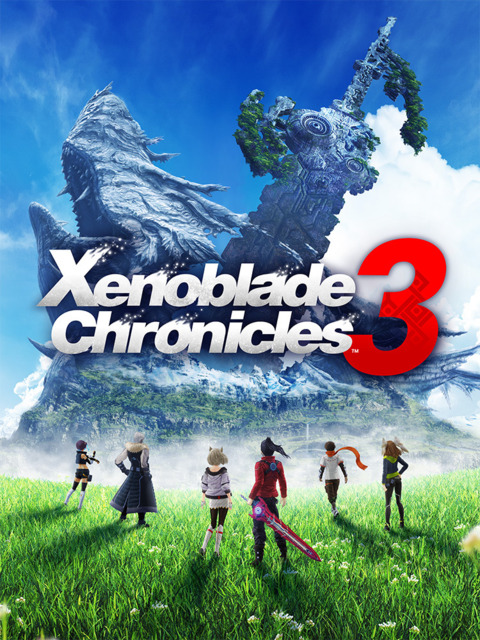A snuffing good time
It’s funny to reminisce that the original Xenoblade Chronicles for the Wii almost never released in North America. Nintendo was convinced the game would be a bust, fortunately they were completely off the mark. Xenoblade Chronicles 3 is the culmination of the best of Monolith Soft and is easily their strongest work to date. With Xenoblade 3, Monolith Soft have solidified Xenoblade as a mainstay franchise, a 1st party title that Nintendo should be proud to stand side-by-side with their other legendary franchises.
Xenoblade 3 immediately hooks players in the opening cutscene as Noah, the protagonist, narrates that the people on Aionis only know one thing: “living to fight and fighting to live”. The two kingdoms of Aionis: Keves and Agnus, are in constant war. The soldiers on both sides aren’t fighting for raw hatred for one another or for political purposes, but literally for their very lives. The Kevesi and Agnian soldiers fight for their colony’s Flame Clock, essentially an indicator of their colony’s health. When the Flame Clock is depleted, everyone in that colony dies. The only way to replenish it, is to kill foes from the opposing faction.
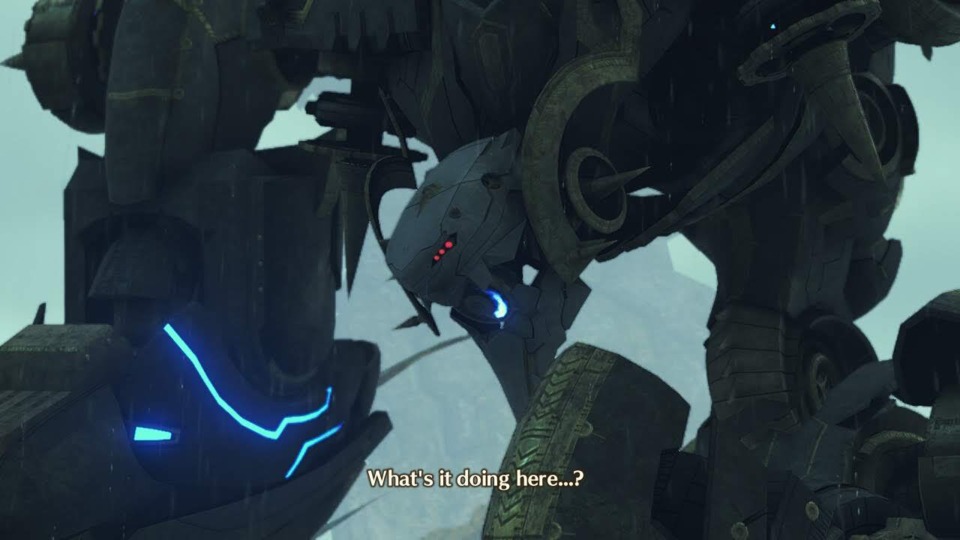
It wouldn’t be a constant war without a constant stream of recruits. Both kingdoms are each managed by their respective Queens. The Queen is responsible for growing new recruits out of test tubes. These test tube babies are rapidly aged and born equivalent to ten year olds. While these beings act and age like regular people, they only have a lifespan of ten years before passing away. At first thought, it would seem fruitless for them to fight, why fight only to inevitably die? However the recruits are taught that reaching the tenth term or “Homecoming” is the greatest honor they can have. People who make it that far, get an audience with their Queen and be sent off peacefully, rather than dying on the battlefield.
Noah is a Kevesi off-seer, whose role is to send off the dead. He is a strange fellow in this world because he plays his flute for both Kevesi AND Agnian soldiers as a sign of respect for the fallen. After vanquishing an enemy Agnus colony, Noah’s team is assigned to pursue a mysterious airship. Surprisingly a band of Agnian troops led by an off-seer named Mio, are also pursuing the same vehicle. A member from the mysterious 3rd party, Guernica, reveals himself, shocking both parties that it is possible for people to grow well beyond ten years.
The parties are suddenly struck by a powerful being known as Consul D from a faction called Moebius. D comments that they know too much and must be eliminated. Guernica activates a device that powers our heroes granting them the power of Ouroborus. Noah and Mio fuse together into a being that looks eerily similar to Consul D, granting them otherworldly abilities to repel the foe. Guernica with his last ounce of strength, explains that they are now Ouroborus, freed from their Flame Clocks, but the enemy of both Keves and Agnus. He informs them that they must travel to Swordmarch to find the answers they seek. Noah and Mio’s teams hesitantly pair up, realizing that their “normal” lives have been upended and the only way to survive is by working together.
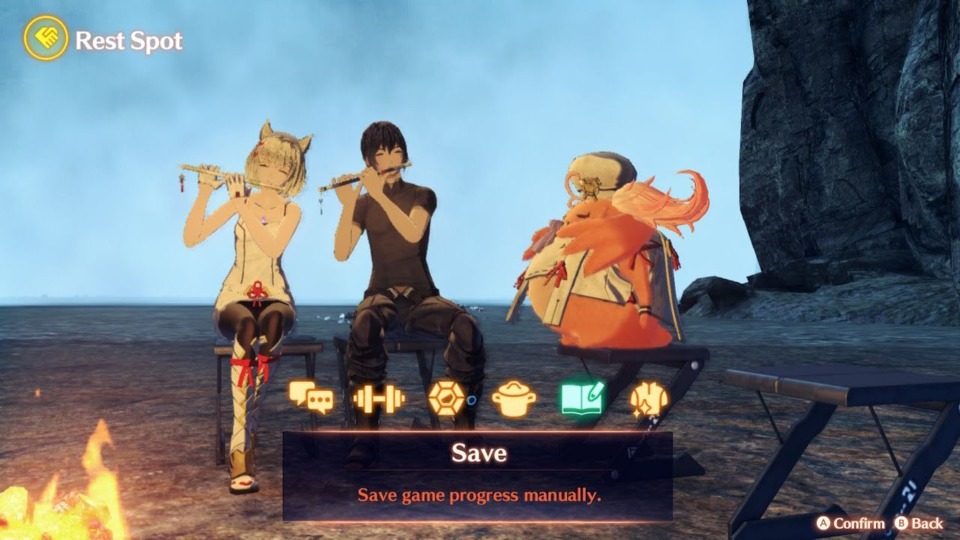
Xenoblade Chronicles 3 will irk some players who are accustomed to more traditional JRPGs.The game is an epic road trip with Swordmarch as the final destination. The early chapters are especially desolate. There are very few NPCs encountered in the wilderness. The first “town” Noah visits after the tutorial area takes more than ten hours to reach. Most of the time, Noah and friends will be resting at campsites or at abandoned Ferronis Hulks. It can feel monotonous going from one monster-filled biome to another without other activities to break up the tedium. Fortunately, the combat in Xenoblade 3 is spectacular and is worth the price of admission alone.
The combat in Xenoblade 3 is similar to the MMO-style combat featured in previous Xenoblade titles but introduces a blend of mechanics from the past two games. In combat, all six characters and a guest Hero character fight at the same time, but they play differently depending on their faction. Kevesi soldiers Noah, Lanz and Eunie have Arts that run on a cooldown like in Xenoblade 1, while the Agnian soldiers, Mio, Taion and Sena have Arts that charge each time a hit lands like in Xenoblade 2.
An emphasis is placed on the classes “playing their role”. Each class has a Talent Art, a super move that charges based on their type. Attackers charge their meter by dishing out damage. Tanks charge their meter by receiving aggro. And Healers charge their Talent Arts by healing and buffing the party. In addition, Healers are the only class that can revive fallen teammates. As Noah and his friends travel through Aionis, they will gain new classes by encountering Heroes through the main story and side quests. There are a total of 25 classes (as of this writing) making for an almost limitless amount of team compositions.
Things get more interesting once our heroes gain the ability to use other classes. Mio, for example, can adopt Noah’s Swordfighter class and learn his Arts and Skills. While Mio is a Swordfighter, she can access the abilities she learned previously as a Zephyr. While class swapping isn’t revolutionary in this genre, what is unique is that our heroes can simultaneously use both Kevesi and Agnian Arts. The Swordfighter class has a high damage Art called Air Slash, but draws aggro. Meanwhile, the Zephyr’s Wide Slash Art grants evasion at the cost of a low crit rate. By using both the Air Slash and Wide Slash Art at the same time, called a Fusion Art, Mio can dish out damage and avoid getting hurt at the same time.
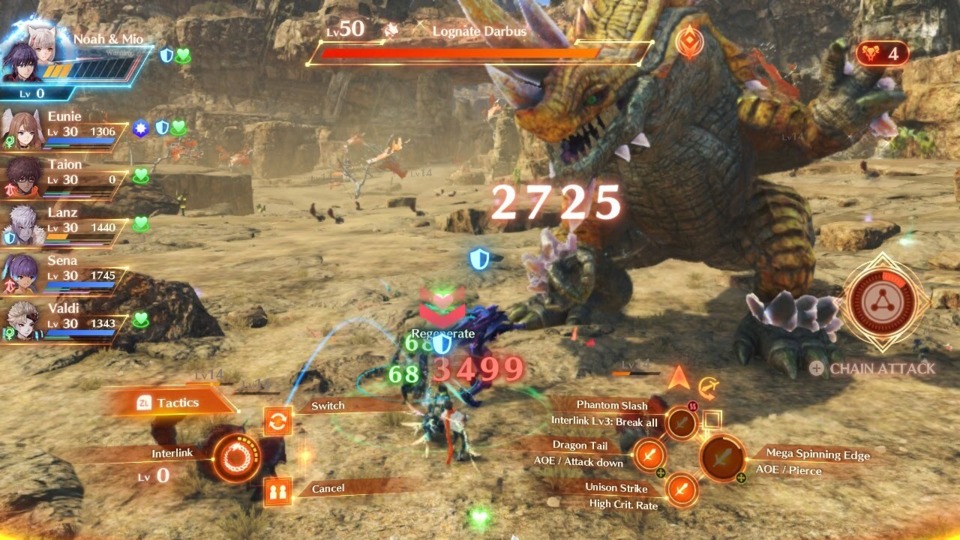
Chain Attacks makes a return in Xenoblade 3. Chain Attacks can be triggered after charging the meter when the party is doing well in combat. Activating a Chain Attack, pauses combat and initiates a mini-game where players strategize what order of actions to take for maximum effect. The goal of the mini-game is to fill the Chain Attack gauge to 100%, with further rewards the higher the percentage is. Attackers are the best initiators, while tanks allow for follow-up attacks when used last. Healers on the other hand can cap the total percentage to 99% allowing players to maximize the Chain Attack meter. Successfully executing a Chain Attack can easily fell bosses in a single turn and grants bonus EXP for overkill damage.
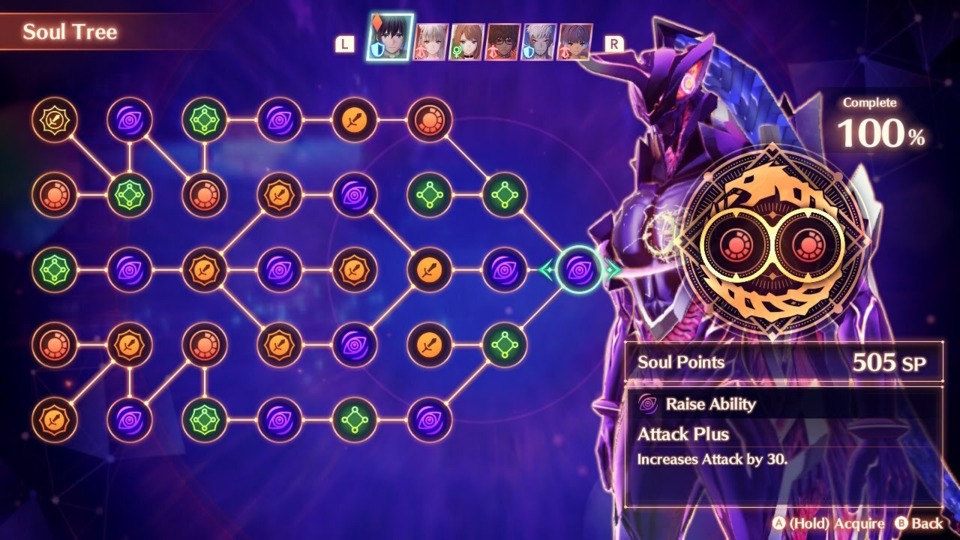
The one mechanic that doesn’t feel as useful are the Ouroborus forms. As you progress through the story, Noah and Mio, Lanz and Sena, and Eunie and Taion respectfully can interlink with one another and become the Ouroborus. Fusing as an Ouroboros grants temporary invincibility and devastating Arts, up to roughly 30 seconds, followed by a lengthy cooldown. To power up the Ouroborus meter, the respective pairs need to execute Fusion Arts in succession. Battles with normal enemies are too short to use the Ouroborus, so they are only useful in longer fights against elite monsters or bosses. The Ouroborus forms are incredibly powerful, but they also hamper the flow of combat. It is sometimes detrimental changing into an Ouroborus form especially with healers and tanks, since players lose a party member with the ability to revive allies or draw aggro respectively. In addition, each of the Ouroborus forms have their own skill trees which feels superfluous given how seldom these abilities can be used.
Xenoblade 3 is the most accessible game in the series and perfect for new players. The game provides extensive tutorials. There is a battle mode where you can practice executing each combat mechanic. Players can enable Auto-Battle where the AI will help fight monsters except against elites and bosses. The difficulty can be tuned in the menu. There is an option to optimize equipment, Arts and Skills. There is a customizable shortcut menu to make things like Quick Saving more convenient. Navigation is a breeze with an easy to see breadcrumb trail for both main and side quests. These quality of life improvements contrast with the systems in Xenoblade 2, where there are no reviewable tutorials and navigation was a simple arrow that pointed to the objective.
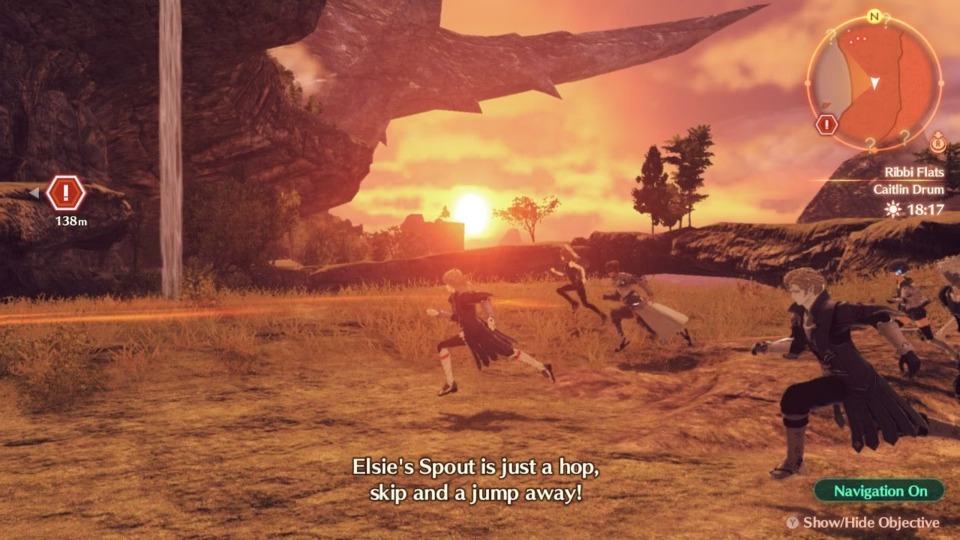
Exploring Aionis is a wonderful delight with a few caveats. There is an impressive amount of optional vistas to visit with large draw distances. Despite the aging and underpowered hardware of the Switch, Xenoblade 3 remains artistically beautiful. Xenoblade 3 technically looks worse than Xenoblade 2. Compared to its predecessor, the open worlds are more linear, have less foliage and have less impressive lighting and particle effects. Xenoblade 3 does not match the sense of scale and dynamism in the environments of Xenoblade 2, but for good reason. Xenoblade 2 is close to unplayable when the Switch is undocked. The resolution can decrease to such an extent that the screen would be a blurry framey mess. Xenoblade 3 makes concessions in graphics for playable framerate in handheld mode.
Ironically Xenoblade Chronicles 3 can look surprisingly better than Xenoblade 2. Monolith Soft employs an extensive amount of pre-rendered cutscenes with smooth transitions to real-time gameplay which helps disguise the Switch’s graphical limitations. They also employ a new upscaling technique which makes real-time cutscenes sharp even on 4K displays. Character faces are remarkably expressive. Their hair moves in a realistic manner. The curvature of their eyes are accurately portrayed when they move their heads at an angle. Their lips sync to both the English and Japanese voice-over options. All of these subtle changes improve the immersion of the game.
The main cast of characters in Xenoblade Chronicles 3 propel an otherwise great game to an excellent one. Each of the six characters occupy a stereotypical archetype to great effect. Noah is the stoic leader. Lanz is the meathead. Eunie is the hothead. Mio is the reserved one. Sena is the cheerful one. And Taion is the tactician. Each member of Ouroborus gets their moment to shine. I found Mio’s character especially intriguing. Mio only has three months to live which adds a greater urgency to the rest of the party. She says a very memorable line that tugged on my heartstrings: “I will keep on living while my flame still flickers”.
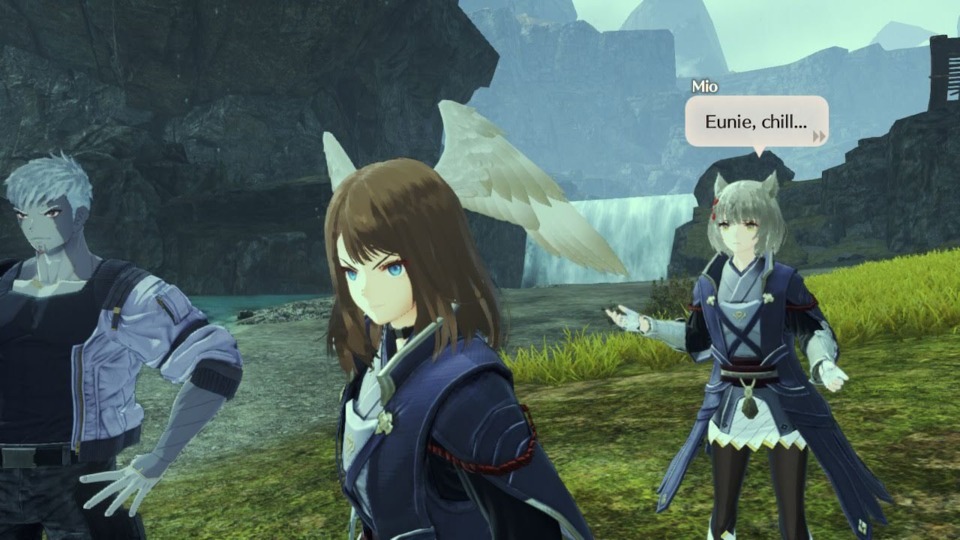
The localization for Xenoblade Chronicles 3 exceeded my expectations of a typical Nintendo title. Not only is the writing poetic, but also full of spice and sass. The game includes British slang like “muppet”, “tosser” and “snuff” but also invents new words like “spark”, “mudder” and “Queen’s wings”. I thoroughly enjoy this type of writing because it adds another layer of nuance to the dialogue. For the record, it seems like people from Keves, especially Eunie and Lanz seem to use these words every chance they get… and it rocks.
Speaking of rock, the soundtrack in Xenoblade 3 is diverse. The game uses a wide spectrum of instruments and music genres. Somber sequences feature piano and flute scores. While battle sequences feature a range of synth and orchestral rock notes. The game can get cacophonous, especially one battle theme where it sounds like they are playing a dozen different instruments and your 7 characters (six from the main cast and 1 guest Hero) all shouting at the same time. The music is good, but it doesn’t meet the same highs as the music in Gaur Plains or Mor Ardain in Xenoblade 1 and 2 respectively.
Xenoblade 3 is far from perfect and its flaws are most apparent with its story. Ironically this over 100 hour JRPG feels too short. Several story elements and vital characters foreshadowed in the first half are either abandoned or rushed at the end. Sena isn’t given the same extensive character development as the other party members but instead used as a prop to develop other characters’ storylines. The writing can get painfully repetitive, such as the numerous instances where Noah and his friends try to convince a character to stop being evil. The Nopon characters Riku and Manana, are underutilized. They are like extras on a set, present in almost every cutscene but don’t have any lines. When they do speak it’s either to serve as a plot moving device or as comedic relief.
There are other nitpicks that bugged me as I played. Inventory management is barely existent and it is frustrating to parse through hundreds of items due to the lack of useful sorting options. It is too easy to be overleveled. Having an overleveled party makes it impossible to improve existing classes and learn new ones. A few cutscenes swap between pre-rendered and real-time rendering so character outfits would change between their in-game canon clothes to their class outfits which is immersion breaking. The Affinity Chart from Xenoblade 1 is back in Xenoblade 3 and it is still pointless. I think I glanced at that screen for a total of 5 minutes throughout my entire playthrough. Some Hero quests and side quests can only be triggered by hearing rumors, but they are not highlighted on the map so they are easily skippable. Lastly, one particular character silhouette in the Class and Hero selection screens is a huge spoiler.
In public interviews with Mr. Takahasi, the creator of the Xenoblade series, noted that Xenoblade 3 is the merger of the worlds of Xenoblade 1 and 2. Unfortunately outside of a few cameos, monster designs and environments it can very well not matter. As someone who invested the time completing the other Xenoblade games and their DLC, the conclusion to the Xenoblade trilogy left me feeling bitter and disappointed. Xenoblade Chronicles 3 can be treated as a standalone game similar to the Final Fantasy series.
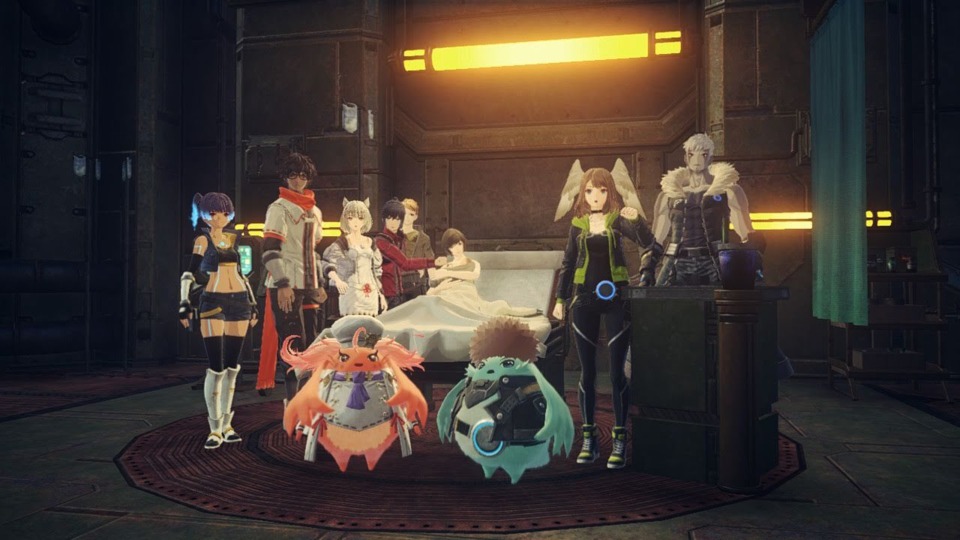
Xenoblade Chronicles 3 is an unbelievable epic, with large environments, hundreds of quests and countless memorable characters. It is rich with complex gameplay mechanics that will keep players challenged. The game’s plot is serious, somber, yet tells an optimistic tale of a group of characters making the most of their limited existence. Xenoblade Chronicles 3 is a contender to be my most favorite JRPG of all-time. Even though the game has numerous flaws especially in the last act, it is still a phenomenal achievement. For a game of this length, very few parts of it felt like filler. The game kept me thoroughly entertained for hundreds of hours; and that is not an easy accomplishment.
